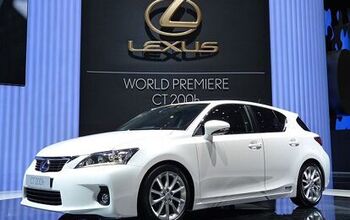2011 Lexus CT200h Review - First Drive

Zipping along the tight and twisty rural roads of France or negotiating the maze of diesel puffing Peugeots in Paris it doesn’t seem to matter – my fuel economy that is. Regardless of the style of driving, the Lexus CT200h hatchback I’m behind the wheel of is registering just under 40-mpg, a few ticks short of the claimed 42-mpg average.
FAST FACTS
| 1. Using the 134-hp hybrid drivetrain borrowed from the Prius, the CT200h gets 42/41-mpg (city/hwy) for a 42-mpg average. |
| 2. A 4-way hybrid drive selector lets you pick from EV, Eco, Normal and a Sport mode that delivers heightened throttle sensitivity and increased steering response. |
| 3. Lexus will offer a F-Sport suspension upgrade to further enhance the CT’s handling. |
| 4. Pricing has yet to be released but the CT200h will be close to the $30,000 mark. |
What might that be? Well, it’s the Audi A3 TDI, a uniquely European Audi that’s also offered here in the U.S. And while the CT will be sold in North America, targeted at cars like the A3, BMW 1 Series and Volvo C30, it’s destined for far greater success on the Continent where those other models make up a significant segment of the market.
Historically, hybrid models have had very little success in Europe, while their popularity has spiked here at home. The opposite is true of diesels. There’s an obvious irony here, as apart from major urban centers diesels make more sense in the U.S., while a hybrid powertrain seems best suited to European style driving.
A HYBRID BUILT FOR EUROPE
So why haven’t hybrids caught on in Europe? For starters, European automakers have been reluctant to adopt the technology and consumers have been equally skittish about buying non-EU cars. But Lexus believes there’s a bigger reason, namely, that no one ever offered a hybrid for Europe. Sure, automakers, (including Lexus and parent company Toyota), have offered hybrids in Europe, but not for Europe.
And so Lexus crafted the CT200h, specifically tailored for European tastes, while exhibiting trademark Lexus quality, luxury and the company’s sophisticated hybrid drive.
So what exactly makes this a Euro-type car? For starters, it’s a hatchback, with five doors and a significantly-sized 14.3 cu.-ft. trunk. And of course, there’s a 60/40 folding rear seat assembly that allows for up to 34.8 cu.-ft. of room.
Next, it’s a premium small car. Traditionally, North American sensibilities have tended towards a philosophy that luxury means large, but over in Europe where space (not to mention fuel) is at a premium, they’ve learned to infuse luxury into smaller packages – and that’s just what the CT does.
As a result, it’s European in its approach to fuel consumption, although with a twist. Rather than opt for a loud diesel (say what you will about how improved modern diesels are, they still sounds like tractors compared to gasoline engines) they’ve fitted the same Hybrid Synergy Drive engine as found in the modern Toyota Prius under the hood. The result is 134-adequate horsepower and a 0-60 mph time of 9.8 seconds. That’s hardly a stunning number, but we can’t harp on the car too much. After all, the A3 TDI is only a second faster to 60 mph – despite 236 ft-lbs of torque.
SPORT MODE DELIVERS INCREASE THROTTLE AND STEERING RESPONSE
To get the most out of the hybrid setup, Lexus has built in four different drive modes that let you customize the driving experience: Sport, Eco, Normal and EV. Like the Prius, EV mode is essentially a gimmick – although it’s an important addition as it does make for reduced taxes in many parts of the world and it allows the car to skip or pay reduced inner city congestion charges in Europe. Eco mode is also similar to that in the Prius with retarded throttle sensitivity to ensure you’re using a light foot.
Switch to Sport mode and not only does the throttle sensitivity pick up, but a more direct steering program is also engaged. While the outright 0-60 mph time remains the same regardless of the mode you’re in (full power is always available at wide open throttle), once you’re already moving, the Sport mode delivers far more immediate acceleration. With 200 volts of power normally available, Sport mode pumps up to 650 volts, meaning that even slight throttle applications make a big difference. In many ways, this electric boost of power delivers the sort of high-torque feeling generated by diesel engines – something that is sure to be appealing to European buyers – and there’s certainly a feeling that you’ve got significantly more than 134-hp underfoot.
Helping make that 134-hp go a long way is a relatively low curb weight of just 3,130 lbs – a factor that also helps give the CT it’s nimble feel.
Switching between the modes is simple with a dial on the center stack, rather than the buttons in the Prius – although EV mode is still engaged via a button. And in case you can’t tell what mode you’re in (which would be hard as they are quite defined) the dash lights up blue in EV or ECO mode, while there’s a red glow in Sport mode. Plus, in Sport mode the hybrid “power” meter on the left side of the speedometer turns into a tachometer.
The obvious downside to this setup is that even though you get a more immediate throttle response, it’s still a CVT transmission. We‘d really like to see pre-programmed “gears” (like on the LS600h L) and paddle shifters – which are a must-have on a vehicle that’s marketed as the sporty side of Lexus. And while we’re asking, instead of the dial, how about a steering wheel mounted control switch for the hybrid modes so you can switch back and forth on the fly?
LUXURIOUS AND AGILE: IT REALLY IS A COMPACT LEXUS
The CT maintains the serene driving experience we’ve come to expect from Lexus over the years, (even being an entry-level model), while delivering a more driver-focus experience than we expected.
Like the Prius and the rest of the Toyota family of hybrids, switching from electric to gas power is seamless and most folks probably wouldn’t even notice it was a hybrid were it not for the badging and interior idiosyncrasies – like the joystick gear shifter.
In Sport mode, with the more direct steering engaged and a less-restrictive stability control program, it’s a rather enjoyable package when the road narrows and starts to twist and turn. With a MacPherson strut front suspension and double-wishbone rear, Lexus actually credits much of a car’s driving dynamics to a rigid chassis and two innovative strut bars – yes, strut bars. While a conventional bar connecting the strut towers will offer rigidity, it will also make for a less pleasant ride. Lexus engineers came up with a solution for this by building a strut brace with a shock in the middle of it that will dampen out much of the harshness of the more rigid structure while still maintaining its shape. As a result, the CT is solid while retaining the trademark Lexus comfort and smoothness.
In many ways it delivers a ride similar to that of the, albeit, more detached sixth-generation GTI, with a solid on-road feel, although again, without the power. In fact, for a front-drive Lexus there’s far less understeer than we anticipated, although it’s still present – with the weakest part of the handling package easily the low rolling resistance 215/45/17 tires.
Even the electric steering is good without the numb on-center feel prevalent in most EPS systems.
Adding to the driving experience is a lower center of gravity, and a cockpit that’s built to suit a driver. The seats are low in the car and nicely bolstered with a thick three-spoke steering wheel that looks lifted directly from the Lotus Evora.
Lexus even paid attention to the location of the pedals, which may sound inconsequential, but isn’t. In most other Toyota/Lexus products you step down on the pedals, whereas in the CT you press against them. Seemingly trivial traits like this are part of a concerted effort by Lexus to appeal to a younger and more enthusiastic driver and are some of the small ways in which Osamu Sadakata, Chief Engineer for the CT200h (and for all of Toyota) let his passion for driving (he owns a track-prepped Miata) flow though to this project.
Overall, its what you might call, (cliché alert) a very European driving experience.
PREMIUM INSIDE AND OUT WITH PLENTY OF FEATURES
In terms of design, the CT is arguably too conservative and could use some more hot-hatch aggression. The choice of colors does, however, make a big impact on how the car looks and while most folks with tend towards the silvers and grays, we love the Matador Red Mica, Starfire Pearl and even the new Daybreak Yellow Mica, which looks a bit mustardy when it’s overcast, but absolutely shines like gold in the sun.
Inside the cabin is elegant yet simple with the aforementioned seating position combined with the hybrid controls and gauges to give a high-tech sporty feel. The rear seat area is functional, although not quite what we’d call spacious.
Base models feature NuLuxe faux-leather that’s pretty close to the real thing and arguably feels more genuine than the real stuff used by some of the competition. And you don’t have to stick with NuLuxe just because you’re on a budget, as its available in a wider variety of colors (including a nice Caramel option), plus it’s made through a more environmentally responsible process that produces 65 percent less CO2.
A Leather Package includes high-grade perforated leather on the seats, a driver’s seat memory and heated front seats – although for some reason Lexus chose to make the heated seat operation a silly push out dial (like the audio controls on a 1990s Pontiac) rather than a more convenient button.
Other option packs include a Moonroof and premium audio system, while a rearview mirror backup camera can also be added. Better yet, get a real backup camera coupled with the Nav system that features the easy-to-use and ergonomically sound Remote Touch system that lets you hunt through menus with a mouse where you “feel” each item. Another stand-alone option is the Pre-Collision system with Dynamic Radar Cruise Control that lets you set the distance from the car ahead an will prep the brakes and tighten the seat belts if it detects a collision.
Dealer options will include an F-Sport suspension upgrade and an optional trim piece on the passenger side of the dash that can be ordered as metal, Ash Burl wood or Bamboo. That may sound trivial, but this one item really helps add a luxury feel to the interior.
Standard features on all CT200h models include full power items, Smart Access keyless entry and a push-button ignition, LED daytime running lights, a leather-wrapped steering wheel, dual-zone automatic climate control, iPod hookup and control, Bluetooth, use of eco plastics for dash and trunk areas and the OnStar-like Safety Connect system.
An with the focus on the safety record of Lexus as of late, we should point out the CT200h comes with eight airbags, stability and traction control, as well as Smart Stop – the name given to Toyota’s brake override feature.
THE VERDICT
With efficient packaging that’s also luxurious and high-tech, plus fuel economy that’s well-beyond best-in-class, about the only complaint one can have about the CT200h is a lack of power. In many ways it’s a testament to how good a car the CT is that we’d love to have 200-hp on command.
Having established that the CT200h is a perfect vehicle for the European market, where Lexus hopes it will double their sales; what about here?
In the U.S. Lexus doesn’t have any lofty ambitions for the CT, targeting just 12,000 units per year, but even those sales numbers will almost double the segment leading BMW 1 Series. And while the 1 Series isn’t really a competitor, with its performance-focused engines and rear-drive setup, there’s a lot more room for the CT in the U.S. market than you might think, offering a compelling alternative to popular urbanite transportation like the MINI Cooper and Smart car, with excellent fuel economy and a luxurious ride in a fashionable package.
Lexus has yet to release pricing, but the CT will cost less than the IS250, which will put it very close to its rival the A3 TDI.
With its long list of attractive traits, the CT should see a lot of first-time Lexus buyers, winning over the small Euro-car faithful with luxury, a sporty drive, impressive fuel economy and Japanese reliability, helping Lexus to secure itself as the leader in the emerging small premium segment. It’s not likely to be an overnight success, but the CT200h is looking down the road, with a hybrid that’s kind to the planet and a business case that’s good for the future of the brand.
RELATED READING
2010 Audi A3 TDI Review
2Audi A3 2.0T
2010 Volkswagen Golf TDI: First Drive
2010 Volkswagen GTI: First Drive
2010 Honda Insight
2010 Toyota Prius III Review
2010 Volvo C30 R-Design Review
2009 MINI Cooper Clubman Review
LOVE IT
- Excellent fuel economy
- Lexus soft (and quiet) ride
- Handles surprisingly well
LEAVE IT
- Could use more exterior style
- More power would be a bonus
- Would like to see pre-programmed CVT “gears” and paddle shifters

With AutoGuide from its launch, Colum previously acted as Editor-in-Chief of Modified Luxury & Exotics magazine where he became a certifiable car snob driving supercars like the Koenigsegg CCX and racing down the autobahn in anything over 500 hp. He has won numerous automotive journalism awards including the Best Video Journalism Award in 2014 and 2015 from the Automotive Journalists Association of Canada (AJAC). Colum founded Geared Content Studios, VerticalScope's in-house branded content division and works to find ways to integrate brands organically into content.
More by Colum Wood
















![2011 MINI Cooper S Review [Video]](https://cdn-fastly.autoguide.com/media/2023/06/26/06091/2011-mini-cooper-s-review-video.jpg?size=350x220)














Comments
Join the conversation
I love mine!